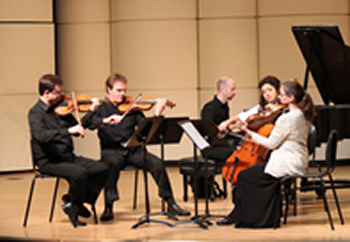The appearance of the distinguished Tokyo String Quartet in the A. J. Fletcher Opera Theatre marked the end of an era. When the originally all-Japanese ensemble was formed in 1969, its members were violinists Koichiro Harada and Yoshiko Nakura, violist Kazuhide Isomura, and cellist Sadao Harada. It is worth searching for the first roster’s DGG recording of Haydn’s complete Opus 50. Kikuei Ikedia replaced Nakura as second violinist in 1974. Peter Oundjian replaced the original first violinist in 1981 until 2002 when a tragic hand injury forced him to leave and undertake a successful career as a conductor. His position was taken by Russian violinist Mikhail Kopelman from 2002 to 2003. Martin Beaver has been leader since then. Clive Greensmith replaced cellist Harda in 2000. After more than 40 years, second violinist Ikeda and violist Isomura decided to retire, and the ensemble decided to make the 2012-13 their last season.
This concert, presented as the first program of the Raleigh Chamber Music Guild‘s Masters Series, may have been the last chance to luxuriate in the gorgeous, warm sounds of the famous Paganini Quartet, a set of Stradivarius-made instruments personally selected and matched by the famous nineteenth century virtuoso. Valued at more than $10,000,000, the set has been on loan to the Tokyo Quartet by the Nippon Music Foundation. The first violin, the “Comte Cozio di Salabue” is dated 1727 while the second violin, the “Desaint,” is dated 1680 and is representative of Stradivarius’ earliest period. The viola, called the “Mendelssohn,” is one of only a dozen made by the master. Its luxurious sound inspired Paganini to commission “Harold in Italy” from Hector Berlioz. The “Ladenburg” cello is dated 1736. The magnificence of the strings was evident throughout this concert.
Joseph Haydn (1732-1809) is justly called the “Father of the String Quartet.” While he had composed some twenty quartets before his Opus 20 set of six, those early efforts were mostly in a simpler classical “gallant” style. With Opus 20, he made a major stylistic break by drawing upon more complex contrapuntal elements from the Baroque era. He treated all four instruments equally, abandoning first violin-dominated works. Haydn evolved the modern sonata form and made use of uneven phrasing. His works seldom lack for surprises such as sudden dynamic changes, false cadences, and rustic folk dance rhythms.
Quartet No. 4 in D is the best-known of the Opus 50 set of six. The opening movement manages to combine a pastoral quality with an underlying energy. False recapitulations keep the listener alert. The deeply profound slow movement is a set of variations. The Menuetto (alla zingarese) has more of a gypsy quality than a courtly dance. The gypsy quality carries over in the Presto finale which has an unexpected ending. The Tokyo Quartet gave a marvelously stylish performance with excellent phrasing and tempos. The give and take between players was a delight to see as well as to hear.
To program the Five Pieces, Op. 5, of Anton Webern (1883-1945) on a concert featuring one of the longest quartets of Franz Schubert (1797-1828) was a brilliant stroke. With Arnold Schoenberg and Alban Berg, Webern founded the so-called twelve-tone or atonal style. Most important, Webern was pithy and VERY succinct in his composition. His description of his Five Pieces, in a letter to Schoenberg, as “the movements are all short,” is an understatement. All five last hardly as long as an average quartet movement. Compositional rules that had governed Western art music are abandoned in pieces of extreme brevity and trail blazing harmonies. The Tokyo Quartet Op. 5 performance was simply brilliant! Webern’s score fully exploited the remarkable sound quality of the ensemble’s Strads. Intonation was precise on dazzling high notes. What a shimmering kaleidoscope of tonal colors! The dynamic range was extraordinary from the most hushed ppp to ff.
Touring quartets did not take up the physically demanding Quartet in G, D.887, by Franz Schubert until the Guarneri Quartet did so in the ’70s. It is chamber music on a massive scale with a first movement lasting between fifteen and twenty minutes depending upon both the tempo chosen and whether repeats are honored. The first and last movements modulate between major and minor keys. The second movement is dominated by a mournful cello theme. The Scherzo juxtaposes a formal scherzo with a landler-like trio section. The Tokyo players assayed the Brucknerian length of the G major quartet with aplomb. Their interpretation had a richly satisfying over-all unity. The sounds of the individual instruments as well as their blending were breath-taking. All those trills were so thrilling!
This concert was preceded by an important adjunct program of the Raleigh Chamber Music Guild as well as of the Tokyo String Quartet throughout its career – the training of young musicians. Three ensembles, two string quartets and a piano quartet from MYCO (formerly Mallarmé Youth Chamber Orchestra) and a string quartet from East Carolina University had received extensive coaching from the Tokyo players in a morning master class. Concert-goers could hear the polished results in a pre-concert sampling from each group. Coaches for the MYCO groups were violinists Richard Luby and Eric Pritchard, cellist Marc Moskowitz, and pianist Clara Yang. Violinist Ara Gregorian coached the ECU group.











